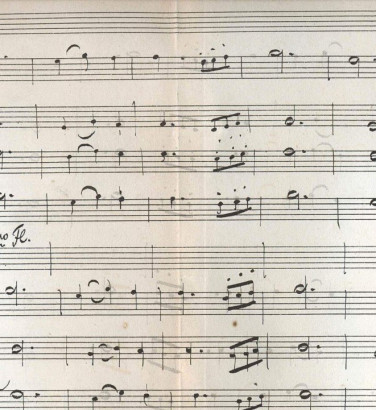
Wind instruments in chamber music
22 Jan 2024
News Story
Frederick the Great (flute) playing chamber music: detail from a painting by Adolph Menzel (1850-52)
The term chamber music covers a vast range of works, the number of performers involved being perhaps the easiest way of differentiating between them. It is generally accepted that music written for a single instrument counts as a separate entity, but as long as the performers will fit in a small room (or chamber), they can be any number you choose.
Two musicians with a history of performing together may be referred to as a duo, but it’s really with three or more that the ensemble gains a recognisable name. From trios, we pass to the quartet (that for strings being by far the most common grouping) and after this there is a gradual decrease in the amount of music written for them. Many composers have quintets to their name, but moving up the scale, notable sextets, septets, octets and nonets are increasingly few and far between. At some point the catch-all term 'chamber ensemble' is substituted, especially once you have to look up the correct term for a work involving ten players or more. (For the record, it's decet, undecet and duodecet for 10, 11 and 12 performers respectively, though whether they can be accommodated in a chamber is another matter.)
Although the piano can be included regardless of the number of players (it's almost a given with only two instruments), these smaller ensembles tend to be dominated by stringed instruments. Sometimes they are joined by a wind player, as in the clarinet quintets of Mozart and Brahms, and as the ensemble gains in size, there is greater potential for parity between the instrumental families. Schubert’s Octet, for example, has three wind instruments to five strings, and Spohr tipped the balance to such winning effect in his Nonet that his line-up (five winds to four strings) has become a standard for that size of ensemble.
Beyond this, however, there is a distinct lack of consistency, and composers have explored all sorts of possible ensembles. Wagner's Siegfried Idyll was originally composed for flute, oboe, two clarinets, bassoon, two horns, trumpet, two violins, viola, cello and double bass - 13 instruments, not quite a chamber orchestra but still positively bijou by his usual standards. There's a delightful Septet by Saint-Saëns for the unusual combination of trumpet, string quartet, double bass and piano, and Stravinsky (perhaps considering Duodecet an ungainly term) wrote a Concertino for flute, oboe, cor anglais, clarinet, two bassoons, two trumpets, two trombones, violin and cello. The latter had such an ear for unlikely instrumental colours that he would probably have delighted in Telemann’s Grillen-Symphonie, whose scoring even Gramophone could not resist describing as ‘gloriously silly’:
Historically, wind instruments have enjoyed a long-established niche of their own (without any stringed instruments being involved) in what is known in German as Harmoniemusik, played by ensembles made up of pairs of oboes, bassoons and horns, with the later addition of clarinets. We would recognise these as chamber music today, but their initial purpose was for outdoor performance, hence many of them being given the title Serenade. This was down to a simple matter of acoustics: the sound of a string quartet did not carry nearly as well outside as that of a wind ensemble.
When it comes to true chamber music which puts wind instruments in the spotlight, this is repertoire in which France’s composers have excelled. There is precedent elsewhere, of course – Mozart’s Quintet for piano and winds comes to mind – but our Café de Paris concert (on 25 February 2024) gave an idea of the breadth of French wind repertoire. The quintet has proved especially popular, sometimes with piano, sometimes without: those by Ibert, Milhaud and Françaix are among the best-known, though there are many more by a host of lesser-known names. Poulenc, however, towers above all these composers with ease: he wrote a sonata with piano for every wind instrument save the bassoon (to the disappointment of bassoonists everywhere), in addition to several duos and trios, all capped off by his irresistible Sextet with piano.
The churlish might argue that a good deal of this music is on the light side (Françaix is especially guilty of writing musical trifles, however delicious), but that is to deny its inherent charm. It is perhaps for this reason that Poulenc’s are so successful: he has a tendency, in the midst of something apparently superficial, to swerve unexpectedly into profundity. It may be the frivolity we remember, but that is very much in the spirit of the age, a contrast to the ultra-serious music-making of the Romantic age - and part of what makes this music ideal for a midwinter chamber music recital.
Related Stories
![]()
Mozart and the symphony
22 December 2025
Stuck between the symphonies of Haydn and Beethoven, where do Mozart's fit in?![]()
Unfinished symphonies
15 December 2025
Your starter for ten: besides Schubert, who has an unfinished symphony to their name?![]()
Andrew Manze: "I've always loved Viennese waltzes and polkas"
1 December 2025
Our Principal Guest Conductor is really looking forward to conducting our Viennese New Year concerts!


